- The Amul example shows how the co-operative model has created an enabling environment for milk producers. Himachal Pradesh, where the new CM has promised an MSP for milk, should take a cue.In Fy22 Banas Dairy distributed a surplus of Rs 1650 crs to Milk Producers.
After the Congress won Himachal elections, chief minister S S Sukhu promised Minimum Support Price for milk. “We will streamline milk procurement, offer to buy 10 litres from every family, set up chilling plants and resell the milk in the market at a subsidy: we will recover costs by levying a cess on the sale of liquor.” (Business Standard 12 December 2022).
Earlier,
I saw a Vlog of an Amul factory being made in Varanasi. The Varanasi plant is
being made by Banas Dairy Palanpur (Banaskantha District Cooperative Milk Producers
Union Ltd) that collects milk and supplies dairy products to Gujarat
Cooperative Milk Marketing Federation Ltd (GCMMF) which distributes and markets
Amul products. GCMMF is an apex body of district milk unions of which Banas
Dairy is one.
The public associates dairy with Amul (Anand
Milk Union Limited). AMUL is a cooperative brand managed by GCMMF. “The word "Amul" is derived from the Sanskrit word Amulya which means 'priceless' or 'precious', a name proposed by the founding leader of Anand Agriculture College, Maganbhai Patel.” Source Dr V Kurien, was the architect of India’s White Resolution . He believed that by placing technology and professional management in farmer’s hands the standard of living of the poor could be improved.
So, how does the milk collection, processing and production
work, under the cooperative model, and can the State, as in the case of the
promise made by the Himachal Pradesh CM, be an alternative?
The
village has a co-operative society collection centre (VDCS), where a
Procurement Supervisor receives milk from producers. Every VDCS has a secretary
and chairman. There is no limit on the quantity of milk a producer can sell.
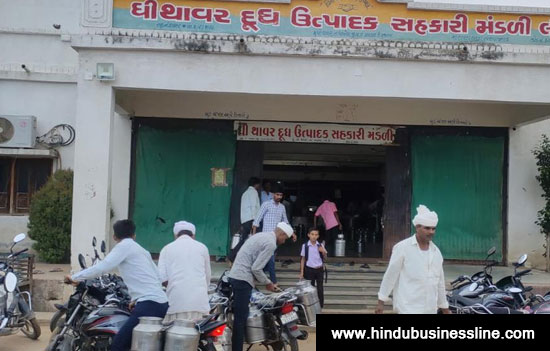 VDCS in Gujarat.
VDCS in Gujarat.Every
collection centre has a computer, automatic milk testing machine where the
weight, volume, FAT and SNF % (Sold not fat) of milk received are checked. The
centre displays the price offered per litre for a given Fat and SNF %.
When milk is received these parameters appear on the screen and the amount payable to the villager is known immediately and or through a mobile message. Amount payable is directly transferred by the Milk Union to the milk producers’ bank account.
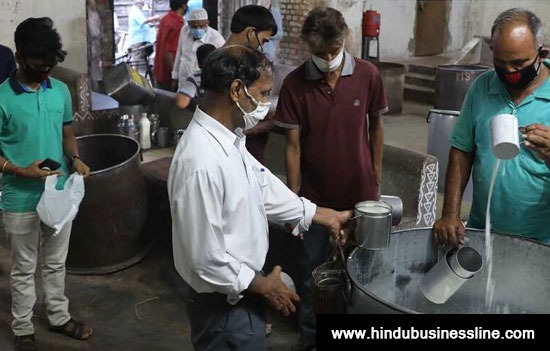
Milk
at centre is collected by a Tanker and taken to a Chilling Centre i.e. usually
2-3 hours away from the village (If the village milk procurement quantity is
large the Centre will have its own chilling plant). A bigger tanker comes and
takes milk from the chilling plant to the dairy where it is processed.
The
above stages might vary in districts for e.g. at Banas Dairy 99.9% milk
collected is chilled at village level. Milk Tankers visit VDCS twice a day,
collects and takes milk to plants at Palanpur or Sanadar. Here the milk is
tested in a laboratory. Once cleared milk is unloaded, processed and treated.
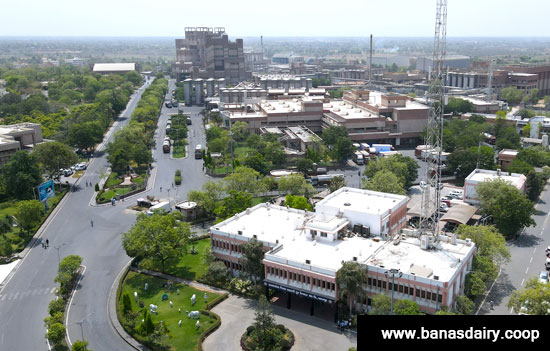 Banas Dairy factory, Palanpur, Gujarat.
Banas Dairy factory, Palanpur, Gujarat. The
Amul site sums up the chain. Member Producers (16.6 million in India, 3.6 million in Gujarat), Village Dairy Co-operative Societies (VDCS-185,903 in India, 18,600 is Gujarat)–District Milk Unions (DMU) and state milk federations like GCMMF-Consumers. (Site viewed on 15.12.2022 at 9.39 am).
According to the National Dairy Development Board’s 2020
Annual Report, “Cooperative milk unions covered about 1,96,114 village dairy cooperative societies with a cumulative membership of 17.26 million milk producers.”
The
DMU (say Banas Dairy) provides VDCS with subsidized
cattle feed, veterinary services, animal breeding services, rural health
schemes and a team of Veterinary Doctors to assist milk producers. It also
gives Dividend, Bonus and Additional Price Differences. Banas Dairy has 3.71 lakh
shareholders, only individuals can be one.
Where does brand
Amul fit in?
The
DMU makes products for GCMMF with brand Amul. Marketing and last mile
distribution of products is done by GCMMF. While there are dairy co-operatives
in most
states, none is as popular as Amul.
Besides
this there are milk traders who buy milk from villagers most of which is sold
to makers of mithai, khoya, paneer (there could be regional variations).
A new plant is being built at Varanasi by Banas Dairy, at a cost of Rs 475 crs. It could be funded by the DMU, banks or the NDDB (National Dairy Development Board) which was created to “promote, finance and support producer-owned
and controlled organisation.”
“The Varanasi factory will have capacity of 5 lakh litres of milk processing, 50,000 litres Ice Cream, 75,000 litres Butter Milk, 20 MT Paneer, 50 MT Curd (Dahi), 15,000 kg Lassi and 10,000 kg Amul Sweets.” Source Milk would be sourced
from villages close to the plant.
Once
operational milk producers would get an assured market for their produce, a
transparent pricing mechanism, sale proceeds directly into their bank accounts
and be beneficiaries of veterinary/rural development schemes by the DMU. Since
products are made for GCMMF the new factory allows Amul to be closer to the
consumer.
When
a DMU like Banas Dairy sets up a plant in another state, the milk collection
and processing model is the same as in the home state of Gujarat. However, milk
producers are not members of the DMU in this case Banaskantha District
Cooperative.
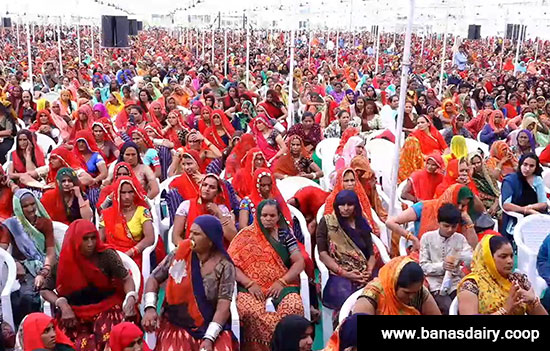 Mahila Diwas, Banas Dairy Gujarat.
Mahila Diwas, Banas Dairy Gujarat. Do Milk Producers get
additional income because of being stakeholders in the co-operative?
Yes.
Surplus is shared at three levels (after removing all costs) with milk producer
members. One at village i.e. VDCS. Two, milk union (DMU). Three at GCMMF level.
Banas Dairy distributed a price difference, in financial year 2021-22, of Rs
1,650 crs to 3.71 lakhs milk producers. This money, is in addition
to what milk producers received for milk sold, is distributed at the end of the
financial year. Source
This enhances rural incomes.
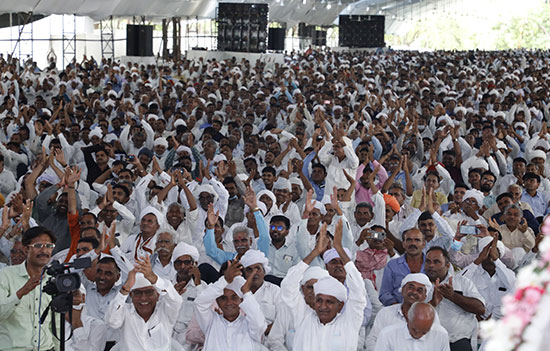 Annual General Body Meeting, Banas Dairy Gujarat.
Annual General Body Meeting, Banas Dairy Gujarat. Note
that milk production is seasonal. It goes down during April to June sometimes up
to July and picks up from August onwards with peak production during the
winters. Milk is produced mainly in the plains and fluctuates in the colder
areas of North India.
Now
returning to the proposed scheme in Himachal Pradesh. The cost of collection
(due to hilly terrain) would be higher and yields lower because the region has mainly
cows. Thus, the surplus at village level would be lower. Fixing a limit of 10
litres per family, procurement at M.S.P., could motivate milk producers to find
ways to beat the limit.
Experience
has shown that government involvement in activities like purchase and processing
breeds corruption and inefficiencies. For e.g.
In
1971 the Maharashtra government introduced a Cotton Monopoly Scheme with the
avowed aim to capture the whole economic value for the farmer, from growing
cotton to selling finished cloth. It proposed to do this by helping farmers get
a fair price for their produce, make available unadulterated cotton to
consumers at reasonable prices, produce textiles and distribute bonus (profit
on operations) to farmers.
In
a 2006 article titled Killing
with Kindness I had examined why this scheme did not lead to
prosperity or prevent farmer distress.
One,
since each cotton procurement area was managed by a grader, this functionary
became a big power centre, extracting bribes from farmers. Two, state had
financial difficulties sustaining over-payments to farmers. These problems
could arise in Himachal too.
To
breach the limit of 10 litres per family, families could on paper show there
are two families when there is one-just like in Punjab where people are
applying for one more metre connection to benefit from scheme of 300 units of
free power.
Conversely,
in Gujarat the government focused on creating an enabling environment, for e.g.
water harvesting, its cotton brand Shanker6, that increased production and farmer
welfare.
Should
any state government venture into milk collection, production and sale or leave
it to a time tested co-operative model is a question worth pondering over? Cross
subsidization (cess on liquor) encourages inefficiencies and rarely works.
Should the government consider exporting India’s co-operative milk model to the global south?
A
shorter version of this article was first published in The
Financial Express
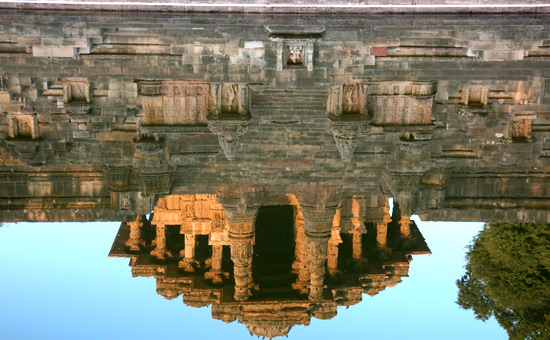 Surya Mandir Modhera is app 90 kms from Banas Dairy Palanpur.
Surya Mandir Modhera is app 90 kms from Banas Dairy Palanpur.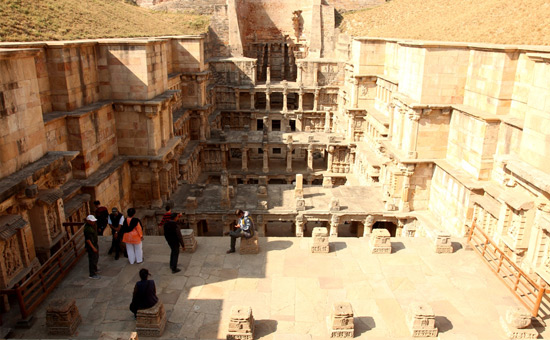 Rani-ki-Vav Patan is app 60 kms from Banas Dairy Palanpur.
Rani-ki-Vav Patan is app 60 kms from Banas Dairy Palanpur.